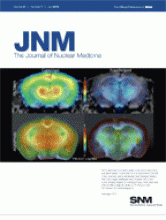TO THE EDITOR: We read with great interest the recent article by Krabbe et al. (1), in which the authors prospectively evaluated the impact and timing of 18F-FDG PET for posttreatment surveillance of oral and oropharyngeal squamous cell cancer. Forty-eight patients were included after completing their initial therapy with curative intent.
The patients underwent clinical follow-up and 18F-FDG PET at 3, 6, 9, and 12 mo after initial treatment. Two nuclear medicine physicians evaluated the PET scans and were unaware of the findings of the current clinical follow-up. At the second, third, and fourth PET scans, the nuclear medicine physicians had access to all available clinical data at the time of the previous scans, including the results of the previous regular follow-up and of morphologic imaging but not of the regular follow-up at the time of the current scan. The PET findings were validated by histopathology or clinical follow-up and by imaging at 18 mo after initial treatment.
When 3- and 6-mo posttherapy results were combined, 18F-FDG PET was found to have detected malignancy in 16 of the 18 patients in whom locoregional recurrences, distant metastases, or a second primary tumor had occurred. It is therefore no surprise that the clinical impact of 18F-FDG PET is best between 3 and 6 mo after treatment. The authors demonstrated that the sensitivity, specificity, and accuracy of 18F-FDG PET were irrespective of the timing of 18F-FDG PET and had ranges of 93%−100%, 68%−76%, and 71%−79%, respectively, during the 4 PET scans (Table 6 of the article). The negative predictive value showed little change between the 4 PET scans, whereas the positive predictive value was overall higher at the 3- and 6-mo scans than at 9 and 12 mo after treatment (61% and 47% vs. 29% and 36%). These findings were surprising to us. We thought that the diagnostic accuracy and particularly the positive predictive value of 18F-FDG PET scans should have been higher at 9 and 12 mo than at 3 and 6 mo because more clinical follow-up and radiographic results after previous PET scans were available for correlation. The results of previous clinical examinations and radiographic imaging after the PET scans at 3 or 6 mo after treatment would help improve the confidence and the accuracy of the later PET scan interpretations at 9 or 12 mo after treatment. The general impression is that, between the end of therapy and PET, there is a decline in false-positive rates that is associated with an increase in positive predictive values and diagnostic accuracy (2,3). The results of the current study, however, appear to be at variance with the general impression. The authors acknowledged that 18F-FDG PET/CT was shown to have high accuracy at 12 mo after treatment, but they did not discuss the findings based on 18F-FDG PET (without CT). We would appreciate a discussion by the authors in this regard.
We noticed that a considerable percentage (50%) of the false-positive findings either were due to mucositis (8/40, or 20%) or were of unknown anatomic substrate (12/40, or 30%). These findings, however, were not correlated with time of occurrence; thus, the readers could not appreciate the 18F-FDG PET pattern of these false-positive findings. Further characterization of these pitfalls of 18F-FDG PET might help identify and decrease the false-positive rates. We would appreciate information from the authors in this regard.
A false-positive finding was shown in Figure 2 that apparently was present in all 4 serial PET scans. Only images of the PET scans at 3 and 12 mo after therapy were shown, and the authors did not provide any clinical information on the location of the 18F-FDG focus that turned out to be false-positive. On the basis of soft-tissue loss seen in the presented radiographic images of the figure, we assumed that the patient had a left tonsillar cancer. We also assumed that the false-positive finding was in the right tonsillar fossa. On the basis of these assumptions, the right tonsillar 18F-FDG uptake was most likely physiologic, because bilateral tonsillar cancer is rare (4). Moreover, if the clinical examinations and neck CT and MRI findings were not suggestive of tumor, the 18F-FDG uptake in the right tonsillar fossa should have been interpreted as physiologic in the 6-, 9-, and 12-mo scans. We would appreciate the authors' comments on this specific case, with inclusion of the neck images of the 4 serial PET scans.
Footnotes
-
COPYRIGHT © 2010 by the Society of Nuclear Medicine, Inc.







